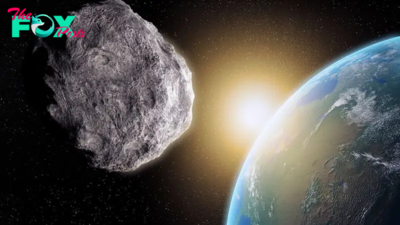Science
Asteroid Bigger than the Dino-Killer Knocked the Solar System’s Largest Moon Sideways
The asteroid collision that killed the dinosaurs 65 million years ago may have been a major cosmic crack-up, but it was nothing compared to a bigger impact that occurred roughly four billion years earlier, between an incoming rock and Jupiter’s moon Ganymede. That’s the conclusion of a new study in Scientific Reports, suggesting that the distant world was knocked completely sideways by the long-ago bombardment.
Ganymede is one of the most complex of Jupiter’s nearly 100 moons—and indeed, one of the most intriguing worlds in the entire solar system. It is the only known moon with its own magnetic field and is believed to have a salty ocean 60 miles deep, lying beneath a 95-mile thick crust. That makes it a prime place for the potential emergence of life. At nearly 3,300 miles in diameter, Ganymede is also the solar system’s largest moon—bigger even than the 3,030-mile wide planet Mercury. But that doesn’t mean it’s impervious to a pounding.
Like our moon, Ganymede is tidally locked—meaning it keeps the same face pointed to its parent planet at all times. In the 1980s, astronomers discovered a radiating system of ripple-like furrows exceeding 1,000 miles in diameter at the center of the moon’s far side. A scar like that could only have been formed by an impact—but just how cataclysmic it was had never been clear. The scale of the collision could have implications for the internal structure and temperature of the moon, which in turn could have implications for the emergence of life. Now, planetologist Hirata Naoyuki of Kobe University in Japan believes he knows more about the force of the impact—and the size of the impactor.
Read more: 2024 Marks an Important Year in NASA’s Search for Extraterrestrial Life
Naoyuki ran a computer model estimating that the incoming ordinance that left the ripples would have to have measured at least 185 miles across—absolutely massive compared to the dino-killing rock—especially considering the relative sizes of Ganymede and Earth. The asteroid that struck our planet measured no more than 10 miles across, or 0.112% of the size of the 7,917-mile diameter Earth. Ganymede’s asteroid was fully 5% of its diameter.
That kind of blow not only left a scar, it also knocked the world cockeyed. According to Naoyuki’s calculations, the far side of Ganymede, where the ripples are, was once located in the north polar region of the moon. But the force of the blow and the added weight of the asteroid tipped the moon on its side. As the New Horizons spacecraft discovered in 2015, a similar collision led to a similar tipping at Pluto, a dwarf planet that rotates effectively on its side, at a 57-degree angle relative to its revolution around the sun. That impact may have had a role in creating Pluto’s litter of five moons—Charon, Nix, Hydra, Kerberos, and Styx.
Ganymede will be studied more closely still in 2034, when the European Space Agency’s JUICE (Jupiter Icy Moons Explorer) spacecraft, launched in 2023, arrives at the moon and goes into orbit around it. Hirata is counting on that to extend astronomers’ knowledge of Ganymede and similar moons further.
“I want to understand the origin and evolution of Ganymede and other Jupiter moons,” he said in a statement that accompanied the release of his study. “I believe that further research applying [to] the internal evolution of ice moons could be carried out next.”
-

 Science4h ago
Science4h agoThe James Webb telescope has brought cosmology to a tipping point. Will it soon reveal new physics?
-

 Science4h ago
Science4h agoAuroras may paint the northern US tonight as Earth reels from 'strong' G3 geomagnetic storm
-

 Science10h ago
Science10h ago'Spiders on Mars' fully awakened on Earth for 1st time — and scientists are shrieking with joy
-

 Science10h ago
Science10h agoEarth's new 'mini-moon' will orbit our planet for the next 2 months
-

 Science15h ago
Science15h agoWhich animals are evolving fastest?
-

 Science16h ago
Science16h agoScientists finally know why ultraviolent superstorms flare up on Uranus and Neptune
-

 Science16h ago
Science16h agoMonster black hole is starving its host galaxy to death, James Webb telescope reveals
-

 Science21h ago
Science21h ago'Completely unexpected': New type of wood discovered by scientists dubbed 'midwood'



























